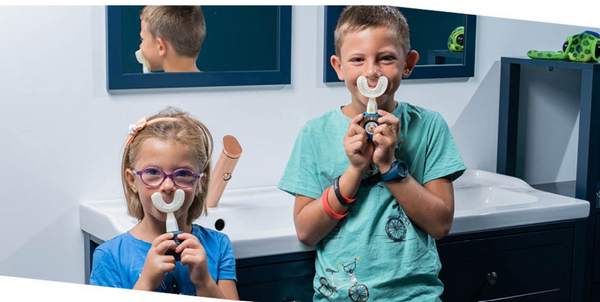It is essential to select the right toothbrush for your child to promote good oral hygiene and encourage healthy habits from an early age. When choosing a toothbrush, consider the brush head size, soft bristles suitable for sensitive gums, and whether to opt for manual or electric options. Additionally, involve your child in the selection process so they feel excited about their toothbrush, which can enhance their enthusiasm for brushing. This guide will help you navigate the available options to find the perfect fit for your child.
Key Points:
- Size: Choose a toothbrush that fits comfortably in your child's mouth and is easy for them to hold. The Y-Brush Kids Toothbrush is ideal, as it fits perfectly in your child's jaw, starting from the age of 4.
- Bristle Type: Soft bristles are the best solution for children's delicate gums and help prevent irritation. The Y-Brush consists of 35,000 nylon bristles for effective and gentle brushing.
- Fun Design: Opt for a toothbrush with characters or bright colors to encourage regular brushing habits. With customizable stickers, the Y-Brush Kids is perfect for children!
Understanding Your Child’s Dental Needs
To choose the right toothbrush, it’s essential to understand your child’s unique dental needs. Children's oral health varies depending on their age, specific dental conditions, and their general hygiene habits. By evaluating these aspects, you can select a toothbrush that effectively supports their dental health and encourages the development of good brushing habits from the start.
Age Considerations
Your child's age plays a crucial role in selecting an appropriate toothbrush. For babies and toddlers, a small-headed, soft-bristled toothbrush designed for their little mouths is ideal, while older children can benefit from a slightly larger brush. As your child grows, transitioning to brushes with fun designs or built-in timers can make brushing more enjoyable and encourage regular oral hygiene. The advantage of the Y-Brush is that it accompanies your child from age 4 to 12 with the kids' model, and then up to adulthood with our size M brush head.
Dental Conditions
Considerations related to your child's dental conditions are crucial when selecting a toothbrush. Children with sensitivities or braces might need specialized brushes with even softer bristles, while those prone to cavities could benefit from brushes with integrated technologies to protect their enamel. It is important to consult your dentist to choose a brush tailored to their specific needs.
Types of Toothbrushes
Understanding the different types of toothbrushes is essential to choose the best one for your child. Here’s a concise comparison:
| Type | Description |
|---|---|
| Manual Toothbrush | Classic brush requiring manual effort. |
| Electric Toothbrush | Operates with batteries or is rechargeable, with automatic brushing motions. |
| Kids' Toothbrush | Specifically designed for small mouths, often with fun designs. |
| Travel Toothbrush | Compact and ideal for brushing on the go. |
| Y-Brush Kids | Designed for children aged 4 to 12, customizable, ideal for sensitive gums and compatible with braces. The advantage: fun and fast brushing without effort! |
Manual vs. Electric
For many parents, deciding between a manual and electric toothbrush can be challenging. Manual brushes are affordable and easy to find, while electric brushes often engage children with fun features, making brushing more enjoyable.
Soft vs. Medium Bristles
An important consideration when selecting a toothbrush is the bristle type. Soft bristles are often recommended for children because they are gentle on sensitive gums, while medium bristles can be more abrasive and may cause discomfort.
Size and Design
When choosing the right toothbrush, consider the size and design, ensuring it fits comfortably in your child’s small hands and mouth. A well-fitting brush will encourage your child to brush regularly and effectively, leading to better oral health.
Handle Length and Grip
Before selecting a toothbrush, assess the handle length and grip. Look for a toothbrush with a non-slip handle that your child can easily hold, which will help them maneuver the brush effectively and promote independence.
Head Size and Shape
Evaluate the size and shape of the brush head before making a decision. A smaller head allows better access to hard-to-reach areas in your child's mouth, ensuring a thorough cleaning.
Features to Look For
Many factors contribute to selecting the right toothbrush for your child, including bristle softness, handle grip, and size. Choose brushes with soft bristles to protect their gums, and a handle designed for small hands.
Additional Functions (Timers, Pressure Sensors)
Incorporating innovations such as timers and pressure sensors into your child's brushing routine can improve their oral hygiene. These features promote good brushing techniques and reduce the risk of gum damage.
Recommendations for Different Ages
For babies, choose a soft-bristled brush with a small head. For toddlers, opt for brushes with bright colors or fun characters. For school-aged children, look for brushes with integrated timers, like the Y-Brush Kids.
Encouraging Independence
Encouraging independence is important by gradually allowing your child to take charge of their own brushing, while still providing age-appropriate guidance.
Importance of Supervision
Even if your child seems ready for independence, it is essential to supervise their brushing to ensure they cover all areas of their mouth. Your role allows for immediate feedback and the development of good habits that will last a lifetime.
Conclusion
Choose an age-appropriate brush with soft bristles and a comfortable handle, and consider electric options if it motivates your child. Involve them in the selection process to make the brushing routine fun. Prioritizing these elements will ensure good oral hygiene from an early age. For a great option, consider the Y-Brush to meet all these needs effortlessly!



